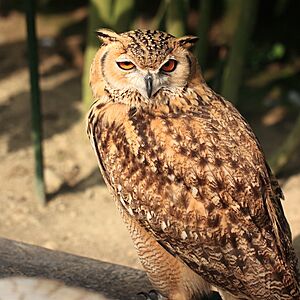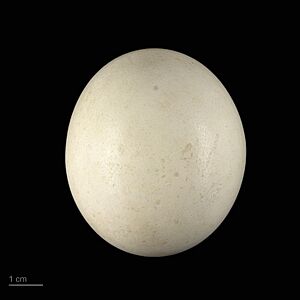Pharaoh eagle-owl facts for kids
Quick facts for kids Pharaoh eagle-owl |
|
|---|---|
 |
|
| At Kakegawa Kacho-en, Kakegawa, Shizuoka, Japan | |
| Conservation status | |
| Scientific classification | |
| Genus: |
Bubo
|
| Species: |
ascalaphus
|
 |
|
| Range of the Pharaoh eagle-owl | |
The Pharaoh eagle-owl (also known as Bubo ascalaphus) is a cool type of owl. It lives in the Middle East and North Africa. This amazing bird belongs to the Strigidae family, which includes many other owls.
Contents
What Does It Look Like?
The Pharaoh eagle-owl has a special coat of feathers that helps it blend in. Its feathers are a mix of black, creamy-white, and tawny (a light brownish-orange) colors. It has big, bright orange-yellow eyes that help it see in the dark.
Its head and upper body are covered in black and creamy-white streaks and spots. The feathers on its belly are pale creamy-white. You might see fine reddish-brown lines on its lower chest and belly.
This owl has a face that looks like a disc, which is common for most owls. A dark rim outlines its face. It has a strong, hooked black beak. On top of its head, it has small ear tufts, which are feathers that look like ears.
The Pharaoh eagle-owl is one of the smaller eagle-owl types. It grows to be about 46 to 50 centimeters (about 18 to 20 inches) long.
There are two main kinds, or subspecies, of the Pharaoh eagle-owl:
- The Pharaoh eagle-owl (B. a. ascalaphus)
- The desert eagle-owl (B. a. desertorum)
The desert eagle-owl is a bit smaller and has lighter, sandier colors. This helps it hide in the desert.
Where Do They Live?
The Pharaoh eagle-owl lives in many dry (arid) parts of Northern Africa. This includes some very empty areas of the central Sahara Desert. You can find them in countries like Algeria, Egypt, Libya, Morocco, and Sudan.
Their home also stretches east into the Arabian Peninsula and the Middle East. They live in places like Iran, Iraq, Israel, Saudi Arabia, and the United Arab Emirates.
These owls love open, empty plains or deserts. They often live where there are scattered palm trees or other local plants. They make their nests in rocky areas, dry riverbeds called wadis, and on cliffs.
Life and Habits
The Pharaoh eagle-owl is a nocturnal animal. This means it is active at night. It comes out at sunset to hunt for food. It usually hunts over an area of about 5 square kilometers (about 2 square miles).
These owls eat almost any small creature they can catch. Their diet includes small mammals, birds, snakes, lizards, beetles, and even scorpions. They like to sit on a high spot and watch and listen carefully. When they spot something moving, they swoop down quickly to catch it.
Reproduction and Family Life
Pharaoh eagle-owls are monogamous. This means they choose one partner and stay with them for their whole lives. They start to breed in the late winter.
Their nest is a simple scrape on the ground, often in a crack or among rocks. The female owl usually lays two eggs. She sits on the eggs to keep them warm for about 31 days. This is called incubation.
Once the chicks hatch, both parents help feed them. The young owls leave the nest when they are about 20 to 35 days old. However, they still rely on their parents for food and care for several more months.
Conservation Status
The Pharaoh eagle-owl lives across a very large area. People have reported that there are many of them in at least some parts of their home range.
This owl does not face any major threats right now. Because of this, it is listed as "Least Concern" on the IUCN Red List. This list helps us know which animals are doing well and which ones need help.



